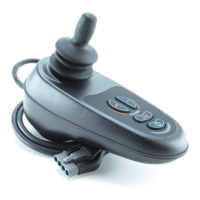PG DRIVES TECHNOLOGY
117
CHAPTER 6 - SERVICING & DIAGNOSTICS
SK77898/2
3.10 Trip Type 10 - High Battery Voltage
This occurs when the control system detects that the battery voltage has risen above
35V. The most common reasons for this are overcharging of the battery or bad
connections between the control system and the batteries. Check the batteries and
the connections to them.
If the trip is still present after the batteries and connections have been checked, then
the Power Module may be defective. Refer to Section 5.
3.11 Joystick Displaced at Power-up
The most common cause of this trip is if the joystick is deflected away from center
before the control system is switched on. When the control system is switched on, the
battery gauge will blink for a short time. Check that the user is not deflecting the joystick
before the blink finishes.
If the problem persists, trip type 7 must be assumed.
3.12 Communications Error
The most likely cause of a communications error is a defective cable between the
Power Module and the Joystick Module. The cable should be checked for damage,
and replaced if found to have a fault. The Joystick Cable can only be replaced by a
person authorized by the wheelchair manufacturer, Refer to Section 1.3 for the
replacement procedure.
If you are not an authorized person then refer to Section 5.
If the problem persists then either the Power Module or the Joystick Module could be
defective. Refer to Section 5.
3.13 Inhibit 2 Active
This occurs when the Inhibit 2 input is active. The Inhibit 2 input is via the INH-2 way
connector and is normally associated with speed limit or actuator functions. The
operation of Inhibit 2 will depend upon the programmed settings and the wheelchair
on which it is being used.
Check all wiring and switches connected to Inhibit 2. If these appear to be in working
order, then the Power Module may be defective. Refer to section 5.
3.14 Inhibit 3 Active
This occurs when the Inhibit 3 input is active. The Inhibit 3 input is via the 3 way on-
board charger (OBC) and is normally associated with this function. The operation of
Inhibit 3 will depend upon the programmed settings and the wheelchair on which it is
being used.
Check all wiring, switches and OBC (if fitted) connected to Inhibit 3. If these appear to
be in working order, then the Power Module may be defective. Refer to section 5.
3.15 Actuator Motor Wiring Trip
This occurs when the control system detects a fault in the wiring to either actuator
motor. Check the motor connectors and wiring.

